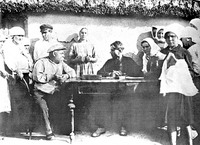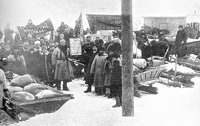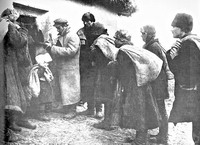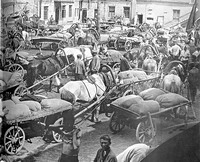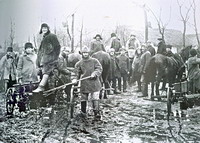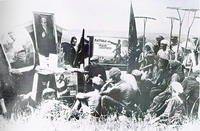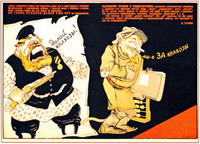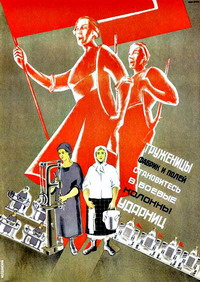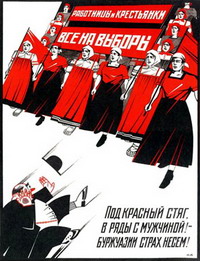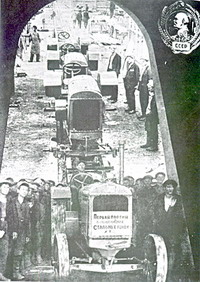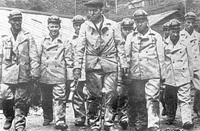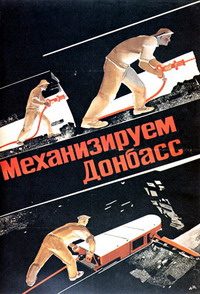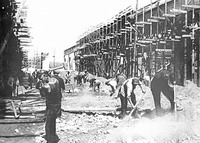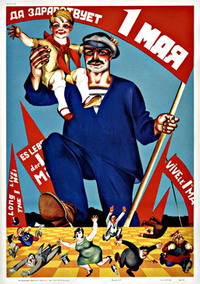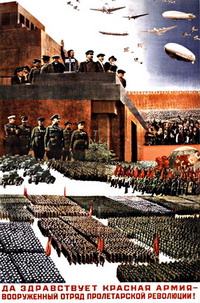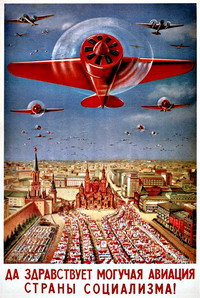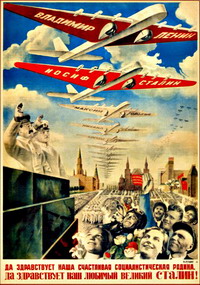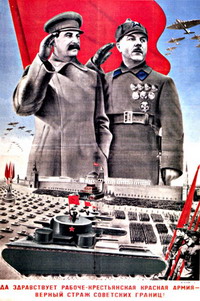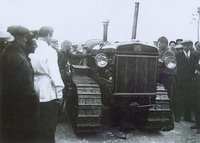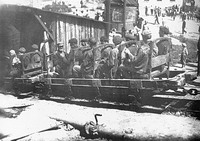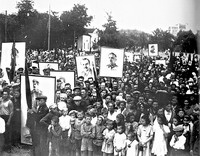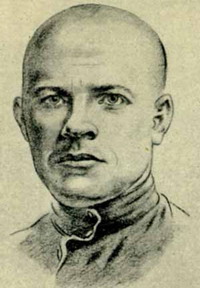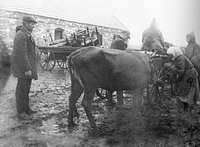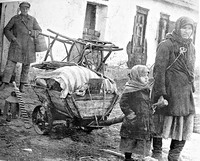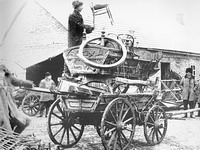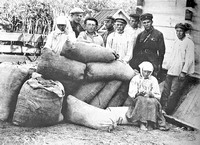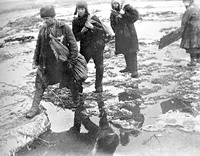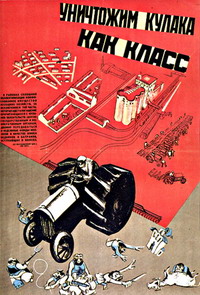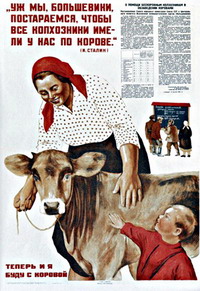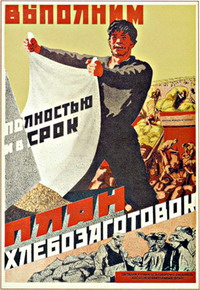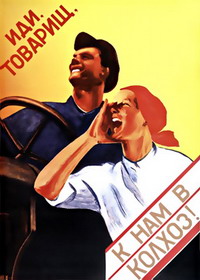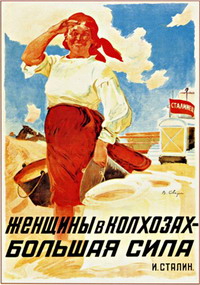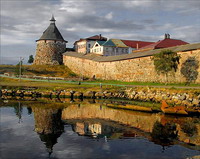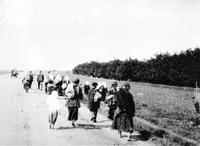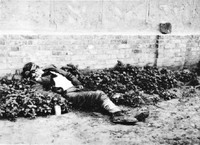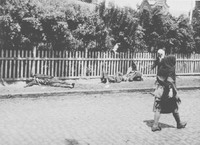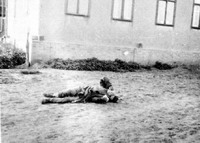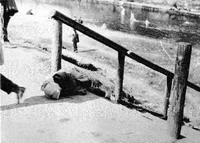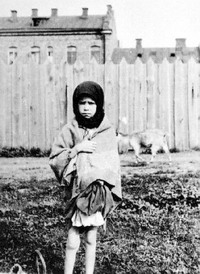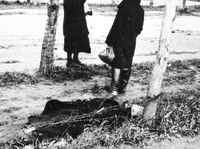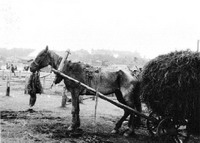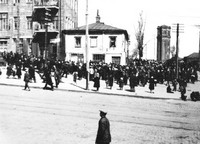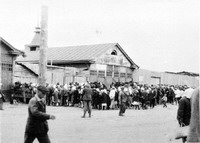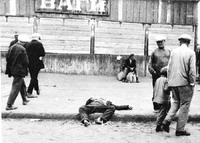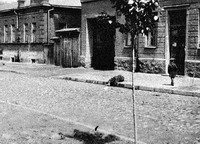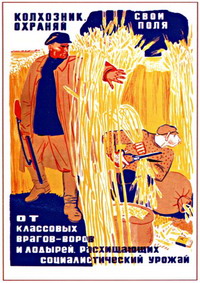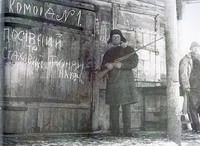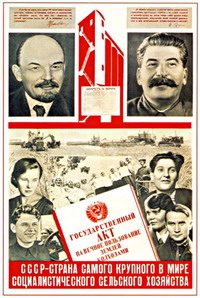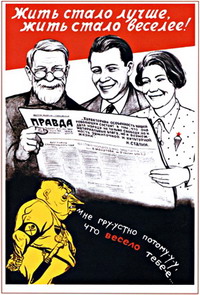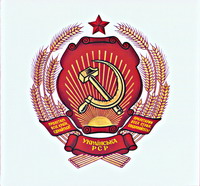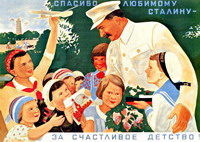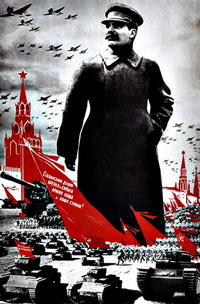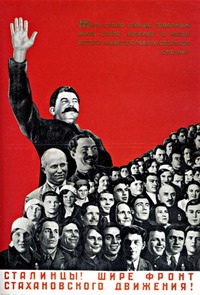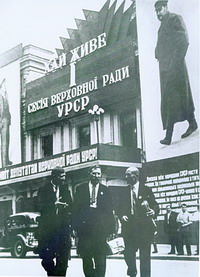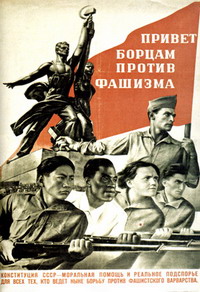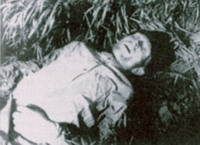consolidate his power after the Bolsheviks started a fundamental pereustriy country, called "Soviet modernization».
consisting of Soviet Ukraine's modernization: industrialization, collectivization, mass repression, "cultural revolution».
In December 1925 held XIV Congress of the CPSU (b), which proclaimed the course of industrialization of the USSR. Next XV Congress in 1927 recognized the priority of the state plan on the market, which meant the collapse of NEP and destruction of commodity-money relations. According to Stalin's plans were not predicting the wear and prescriptive, that is to be binding. Supposed to achieve 19% annual growth of industrial production, and in 1929, XVI Conference of the CPSU (b) adopted a still higher growth. Opponents of emergency measures, and overflow - N. Bukharin, A. Rykov, Tomsk and others - were declared "right prevaricator and during the" cleansing "of the party expelled from its ranks. Based on the parameters of the first Five Year Plan for 1928/29 - 1932/33 years respectively were developed plans for economic development of Ukraine, approved by the Ukrainian Congress of Soviets XI.
first five-year was the amount of annual plans, which are constantly upwards adjustment was made. For Ukraine, the intense growth in installed heavy machinery, chemical industry, production of electricity. In fact fact the structure of the economy, is designed not to introduce new technologies, and energy and raw materials.
on the global economic crisis, 1929-1933, give the impression of rapid economic progress in the USSR. This entailed the Bolshevik leaders want more stretch and force people to make a big leap into socialism. Stalin established a growth rate of industrial production for the second year 32% five-year plan, and more - 45%. This "nadindustrializatsiya" pidkriplyuvalasya no real opportunities. Some industries have developed ahead of others behind. As a result of new buildings did not have enough funds, skilled personnel and equipment. To attract new resources were used by any measure.
industrialazatsiyi sources: public sector revenues, revenues from the state monopoly on foreign trade, increased exports of raw materials and agricultural products abroad, "price scissors" between industrial and agricultural products, nationalization of industry, abolition of private sector (Collapse NEP); cancel conversion chervonets, inflation, increasing to standards while maintaining the existing salary; lengthening the working day, the collectivization, dispossession; coercive government loans; work prisoners labor enthusiasm, Stakhanov movement, increase in prices for wine and alcoholic beverages; sale abroad of national cultural values; antireligious campaign, robbery of churches, increase direct and indirect taxes, the introduction of the card company's products and distribution of basic necessities, reducing living standards.
get this thing as overflow when capital construction plan several times, but each of them had done.
During the first five-year plan in Ukraine was built about 400 new businesses, including the Dnieper hydroelectric plant, tool steels in Zaporozhye Dniprospetsstal "Kharkov tractor factory, mine in the Donbass, and others. Large industry in Ukraine over to the All People's Commissariat. Thus, Ukraine, like other republics, was deprived of economic independence. Administrative and policy management techniques have become major development in the Soviet economy.
To prove the first five-year triumph, Stalin manipulated statistics. Special Politburo decision to individual agencies have been forbidden to print the results of their work. The growth of industrial production podavalosya not in a particular calculation, as in rubles. So, it was enough to set great prices on new products, as gross indicators rose sharply. This enabled to announce implementation of the first five-year plan for 4 years and 3 months. Annual growth in industrial production averaged about 16%, ie less than planned.
during the Second Five-Year Plan 1933 - 1937 growth rates were determined at the level of 16,5%. In Ukraine, were commissioned steel industry giants - Zaporizhstal, fitness, Iron and Novokramatorsky Heavy Machinery Plant - one of the largest in Europe.
implementation of the first Five-Year Plans required extraordinary efforts of the USSR. And five-year plan were not designed to raise living standards. Moreover, starvation 1932 - 1933 рр. killed millions of people zapustilo village, town and new buildings, restored the cheap labor force. Shakhty affair in Donbass - the trial of the old coal industry specialists - has launched an organized persecution of pre-revolutionary specialists with diplomas.
Bolsheviks not provide adequate value material incentives work. Rationing system gave workers and employees the opportunity to purchase a minimum of goods. Ignoring the economic leverage of labor productivity growth, the leaders of the Bolshevik Party and the government tried to use the enthusiasm of the masses, as well as unpaid work of millions of innocent prisoners. Socialist competition (Stakhanov movement, etc..) Will become the principal form of struggle for higher values Labour.
provided for in the Bolshevik plans displacement capitalist elements resulted in the physical destruction of large parts of the economically active population - the so-called "kulaks" in the village and the owners of private enterprises in the city. Increased commodity hunger for efforts in the heavy industry were accompanied by a chronic decline of social services and light industry. In order to maintain the pace of development of industry, workers and technical officers actually assigned to enterprises and institutions and misconduct equaled to criminal offense.
Thus, the positive outcome of the industrialization of Ukraine was the growth of heavy industry (nearly 11 times), construction of new mines, power plants and the resulting transformation of Ukraine on industrial and agricultural country, which is the level of individual industries ahead of some European states. Adverse effects: disruption of agriculture, light and food industries inefficient and uneven distribution of productive forces; increased centralization of industry, ignoring the economic mechanisms of economic development, reducing living standards (distribution of state loans, sale of alcoholic beverages, queues, ration card, chronic shortage of goods and services, housing problems, etc.).
Soviet leaders, taking the modernization of the industrial potential of the country immediately faced with three problems: money, raw materials and labor for the development industry. Get it all came from the peasantry, which constituted most of the people. However, the peasant-owner was uncomfortable and unwanted figure for the party-state apparatus, on behalf of the people rozporyadzhavsya industry. The state could not provide the accelerated pace of industrialization, when dealing with millions of individual farmers. Having at least some production facilities, it had depended on state structures. While the farmer himself decided that he sow and carry to the market, it depended on the state, which had to feed the city and the army. Therefore, under the pretext of concern for the welfare of rural population growth would create a party to a collective farm village controlled.
But Stalin's collectivization plan - is not only a convenient means of providing the population of cities and the army food, and industry - raw materials and labor. Moreover, it was believed to strengthen the social base of the dictatorship of the proletariat: on the one hand, the collectivization of the peasantry stimulated proletarianization process (processes and dekulakization rozselyanyuvannya), on the other - along with industrialization, it opened the way to eliminate multistructure in the economy.
First Five Year Plan envisaged that Ukraine will be combined into collective farms 30% of farms. But at the November 1929 Plenum of the CPSU (B) were taken on a continuous accelerated rate of collectivization. Secretary of the CC CP (B) S. Kosior supported the proposal of complete collectivization within one year. Plenum Resolution on Ukraine's agriculture and work in the countryside "in Ukraine provided the highest rates of collectivization as compared to other Soviet republics. In January 1930 Ukraine carried by the group of regions, where collectivization was to be completed in autumn 1931 - spring 1932
In the process of collectivization can be divided into several stages:
- 1929 - 1930 рр. - a rapid collectivization, turned on the merits in communizing; into collective farms took away everything: tools, cattle, horses, birds, a situation compounded by excessive efforts of local governments: on January 20, 1930 in the republic 15,4% were collectivized farms, and on March 1 - 62,8%, in many places there were performances of anti-Soviet peasant village plunged in the vortex of self-destruction. The peasants started to sell or slaughter cattle hide or tamper with implements. In 1928-1929 he was killed in Ukraine to 50% of livestock;
- 1930 - maneuver Stalinist leadership of transferring responsibility to local party and Soviet bodies (Article Stalin in early March 1930 "Dizziness From Success", the ruling of the CC CPSU (b) on March 14, 1930 "On distortions against the party line in the collective farm movement "). Began a massive exodus from the farms. In spring 1930, the collective farms of less than one third of rural households, most nezamozhnytskyh;
- 1931 - 1933 рр. - a new phase of solid collectivization, speeding up its pace, ending up mostly of collectivization in Ukraine (70% collectivized households);
- 1934-1937 biennium - the final stage of collectivization. In 1937 collective farms had 96,1% of sowing areas.
important element of collectivization was the so-called "cannibalization" and actually rozselyanyuvannya village. First, in 1927 - 1928's, wealthy peasants to a policy of restrictions - increased taxes, restricted land lease, prohibiting use of hired labor, buy machinery, equipment. In April 1929 Stalin defined a new strategic task - to move from policy to policy restrictions eliminating the kulaks as a class. In late January 1930 was published ruling CPSU (B) on measures to eliminate the kulak farms in regions of solid collectivization. It starts mass repressions against rich peasants and those who did not want to enter into collective farms. In Ukraine during the years of total collectivization was expropriated about 200 farms (along with their families - 1,2-1,4 million people, including - 860 thousand deported to the north of Siberia).
One of the most brutal crimes of Stalinism against the Ukrainian people was the famine of 1932-1933 was caused by his immediate forcible removal of bread from the peasants. But in fact it caused a whole set of national political and socio-economic factors:
- need to destroy the Ukrainian peasantry as a deliberate national groups that threatened the imperial interests of Moscow;
- exorbitant for peasants grain reserves;
- excessive grain exports;
- reluctance collective farmers to work in the public sector;
- government confiscation of food supplies;
- economic failures, the attempt to carry out socialist construction of military and communist methods.
During January-November 1930, Ukraine had harvested 400 million pounds of bread for the same period of 1931 - 380 million pounds. Even seized seed fund. August 7, 1932 VTSVK and the USSR Council adopted a law on protection of state property that the theft of kolkhoz or cooperative property involved the execution or imprisonment for not less than 10 years with confiscation of property. In this draconian document popularly called the "law of the five ears».
Despite the unprecedented cruelty, run grain procurement plan in 1932 failed. In order to "fix" the situation in Ukraine sent emergency Bread Procurement Commission headed by Molotov Sovnarkoma USSR. "Stronger" leadership of the CP (B) - Second Secretary of Central Committee and secretary of the Kharkov (metropolitan) Regional Party Committee is the personal envoy of Stalin Postyshev, conducted reprisals against the Ukrainian Communists. Confiscate the peasants is not only corn but also all the food.
exact figure death toll from starvation 1932 - 1933 can not install. Researchers call data from 3,5 to 12 million people.
result of the famine was finally broken the resistance of peasants kolkhoz-feudal system and significantly undermined the age-old force in defending national rights. Collective-farm system was one of the foundations of a command economy and totalitarian regime.
main result of collectivization was carried out by industrial leap, for which I paid a heavy price: the victims of violent dispossession and famine, loss of sense of owner farmers, prolonged degradation and disorganization of Agriculture.
 English
English

